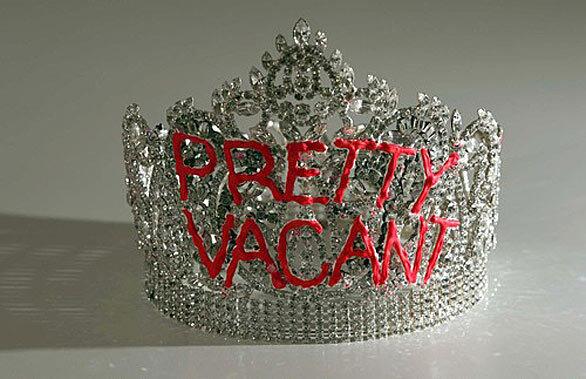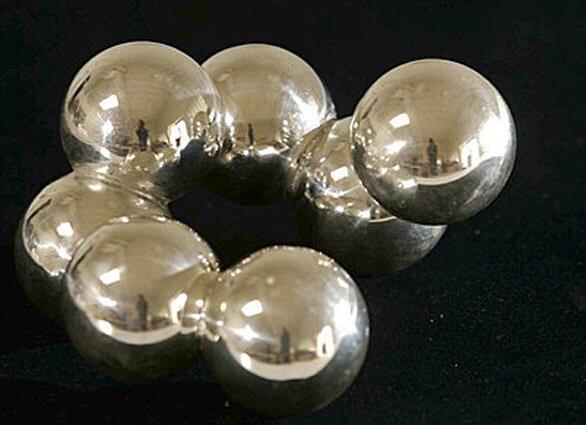Tom Binns’ costume jewelry: trash and treasure

By Booth Moore, Los Angeles Times fashion critic
Tom Binns has pioneered the junk-jewelry genre, making treasures out of trash and trashing treasures silver collars etched with the words statement piece, triple strands of mismatched pearls the size of gum balls, asymmetrical crystal chokers with neon-paint graffiti, forks bent into cuff bracelets.
Before there were outsized, tangled chain necklaces at Target and jumbled pearls at J.Crew, Binns was giving new meaning to the term statement jewelry with a wink and sometimes a middle finger. The influential (and devilishly profane) designer is the father of the irreverent, more-is-more trend that has spawned a generation of like-minded labels, including Subversive, Bing Bang and Fallon, and made costume jewelry one of the few bright spots in retail.
Pretty Vacant Tiara with rhodium and crystal.
More in Image:
• Jewelry inspired by Mother Earth
• Tom Binns’ costume jewelry is trash and treasure
• Flower jewelry, fresh and affordable
• The gilded age of costume jewelry | Photos
• Buying and collecting costume jewelry | Photos
• How to sell your gold and diamond jewelry
• Downtown L.A.’s jewelry district has bargains for the bold
(Irfan Khan / Los Angeles Times)

A native of Belfast, Northern Ireland, Binns has been living and working in Venice Beach for the last four years. The walls of his airy studio are all white except for two paintings — one reads “Vague, Vogue, Vomit,” and the other pictures a Chanel logo next to the McDonald’s golden arches and a swastika. Aggressive, yes. But what else would you expect from a guy who got his start in London during the punk rock era, thinks everyone is stealing his ideas (he may be right), and is struggling to be anti-establishment even as his glittery pieces regularly land in the pages of Vogue and on such fashion plates as First Lady Michelle Obama?
Tom Binns floral cuff.
More in Image:
• Jewelry inspired by Mother Earth
• Tom Binns’ costume jewelry is trash and treasure
• Flower jewelry, fresh and affordable
• The gilded age of costume jewelry | Photos
• Buying and collecting costume jewelry | Photos
• How to sell your gold and diamond jewelry
• Downtown L.A.’s jewelry district has bargains for the bold
(Robert Lachman / Los Angeles Times)

After Sept. 11, 2001, Binns checked out of the New York fashion scene (not that he was ever that checked into it). He doesn’t own a car, begging rides to Whole Foods instead, and spends his free time cycling at the beach. With his thick black eyeglass frames, khaki pants and sun-tanned face, he’d fit right in with Venice’s artsy set, but he prefers to keep to himself. He doesn’t even go to Paris to sell his collection to buyers, leaving that to his staff instead.
“I don’t want to go, I don’t want to dress up, I don’t want to have people ... checking me out, saying, ‘Why are you wearing those shoes — they’re really not happening.’ ” Binns’ speech is peppered with four-letter words, but also with endearing Britishisms such as “luvvie” and “trolley.” He may play the rebel, but he¡¦s really a teddy bear.
Tiered crystal and pearls necklace.
More in Image:
• Jewelry inspired by Mother Earth
• Tom Binns’ costume jewelry is trash and treasure
• Flower jewelry, fresh and affordable
• The gilded age of costume jewelry | Photos
• Buying and collecting costume jewelry | Photos
• How to sell your gold and diamond jewelry
• Downtown L.A.’s jewelry district has bargains for the bold
(Irfan Khan / Los Angeles Times)

Hes currently producing 30 collections, with pieces ranging from $180 to $25,000, so theres something for everyone classic hoop earrings, cuffs decorated with silver skulls, necklaces with swarms of sculptural gold butterflies or clusters of flower-shaped crystal brooches.
Its as if people from outer space came down and landed in Africa and met the Masai, and this is how they interpreted their look, Binns says, holding up a futuristic-looking collar of concentric silver rings.
Binns’ Molotov Cocktail necklace.
More in Image:
• Jewelry inspired by Mother Earth
• Tom Binns’ costume jewelry is trash and treasure
• Flower jewelry, fresh and affordable
• The gilded age of costume jewelry | Photos
• Buying and collecting costume jewelry | Photos
• How to sell your gold and diamond jewelry
• Downtown L.A.’s jewelry district has bargains for the bold
(Irfan Khan / Los Angeles Times)
Advertisement

Another necklace, from the Nouveau Raj collection, is dripping with the finest crystals and two slabs of blue beach glass. Its an interesting juxtaposition, and it works. If you go on the beach and you see a piece of glass, you pick it up, the designer explains. You put it on your bathroom shelf and you remember the day when you were walking ... it becomes something precious to you because the moment was precious.”
Nouveau Raj collection necklace.
More in Image:
• Jewelry inspired by Mother Earth
• Tom Binns’ costume jewelry is trash and treasure
• Flower jewelry, fresh and affordable
• The gilded age of costume jewelry | Photos
• Buying and collecting costume jewelry | Photos
• How to sell your gold and diamond jewelry
• Downtown L.A.’s jewelry district has bargains for the bold
(Kirk McKoy / Los Angeles Times)

Binns likes riffing on the idea of whats precious. The Get Real collection uses laminated magazine cutouts of jewelry. I appropriated appropriations. This is Lanvin, this is Cartier, he says, pointing to the two-dimensional gems cutouts assembled into a collar. I cut up the jewelry, stuck it all together and reassembled it.
The concept, introduced during Paris market week in April, was a joke, he insists. But of course everybody loved it. So now, hes manufacturing the joke gems, and selling them for $100 each. If you cant afford the real [stuff], you can have a paper cutout, he says. Its virtual jewelry! Im virtually rich!
A crystal and neon necklace made with hand-painted rhodium.
More in Image:
• Jewelry inspired by Mother Earth
• Tom Binns’ costume jewelry is trash and treasure
• Flower jewelry, fresh and affordable
• The gilded age of costume jewelry | Photos
• Buying and collecting costume jewelry | Photos
• How to sell your gold and diamond jewelry
• Downtown L.A.’s jewelry district has bargains for the bold
(Irfan Khan / Los Angeles Times)

The son of working class parents, Binns moved to London in his 20s to attend art school, then started working with Vivienne Westwood and Malcolm McLaren, making pirate-themed jewelry to go along with their New Romantic clothes. In 1981, he produced the first collection under his own name, all in rubber. His rubber fish bracelets that wrapped around the wrist were an instant hit. He went on to make pieces out of safety pins and nails, then, in the 1990s, to collaborate with several designers, creating minimalist beach glass and driftwood crosses for Calvin Klein, and over-the-top, twisted chains for Narciso Rodriguez.
Cube Collar, made of sterling silver.
More in Image:
• Jewelry inspired by Mother Earth
• Tom Binns’ costume jewelry is trash and treasure
• Flower jewelry, fresh and affordable
• The gilded age of costume jewelry | Photos
• Buying and collecting costume jewelry | Photos
• How to sell your gold and diamond jewelry
• Downtown L.A.’s jewelry district has bargains for the bold
(Irfan Khan / Los Angeles Times)

Until 2004, when Binns teamed up with his business partner Christina Viera-Newton, he was making only two or three of each piece. She helped transform his couture-like operation into a business with more accessible pieces and prices. Dean Stephen, who heads sales and operations, would not be specific about the companys financials other than to say, Since January 2007 we have doubled our vendors year on year. We have gone from 25 to 50 to almost 100 vendors today. Stores include Bergdorf Goodman, Maxfield in L.A., Colette in Paris, Joyce in Hong Kong and Ikram in Chicago. In 2006, he won the coveted Council of Fashion Designers of America Accessory Designer of the Year Award.
Round Ball bracelet.
More in Image:
• Jewelry inspired by Mother Earth
• Tom Binns’ costume jewelry is trash and treasure
• Flower jewelry, fresh and affordable
• The gilded age of costume jewelry | Photos
• Buying and collecting costume jewelry | Photos
• How to sell your gold and diamond jewelry
• Downtown L.A.’s jewelry district has bargains for the bold
(Irfan Khan / Los Angeles Times)
Advertisement

Last month, Binns opened his first store, on Perry Street in New York, stocking his current collections as well as archival pieces. Hes gaining recognition in no small part because of Obama, who wore one of his tangled pearl necklaces to a gala in February. It was exactly what Im trying to say with my work, he says of that moment. Its actually the integrity thats precious, not the material. Value is not what they say it is, its what you feel it is. And she looked like a million dollars.
Now, hes ready to take his business to the next level that could mean taking on a financial backer, making bags or T-shirts, even a cheap chic line for Target (if Target were to come calling, that is).
Imagine what he could do with that bulls-eye.
Large crystal collar.
More in Image:
• Jewelry inspired by Mother Earth
• Tom Binns’ costume jewelry is trash and treasure
• Flower jewelry, fresh and affordable
• The gilded age of costume jewelry | Photos
• Buying and collecting costume jewelry | Photos
• How to sell your gold and diamond jewelry
• Downtown L.A.’s jewelry district has bargains for the bold
(Irfan Khan / Los Angeles Times)



